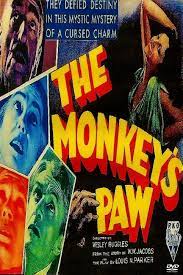
An antique shop owner, Grimshaw (Hay Petrie) tries to sell a mask to a dealer (Sydney Tafler) but he is more interested in a dried-up monkey’s paw. The curio owner says the paw is not for sale. The man convinces the shop owner to sell it to him.
The dealer then visits the Trelawne shop to look at a picture that Mr. Trelawne (Milton Rosmer) wants to sell. Mrs. Trelawne (Megs Jenkins) refuses to sell the picture as it was a present from someone. The dealer then offers to swap the picture for the monkey’s paw. The Trelawnes’ friend, Kelly (Michael Martin Harvey), panics when he sees the paw. Kelly tells them that the paw has the ability to grant the holder three wishes, but that each wish comes with a terrible price. He also relates a story that proves his claim. Before the dealer leaves Mr. Trelawne trades the picture for the monkey’s paw.
Mr. Trelawne has not had a good year at the bookmaker’s. He owes Morgan (Vincent Lawson) two hundred pounds. The Trelawnes’ son, Tom (Eric Micklewood) wants to be a motorcycle racer. The prize for winning the race is 200 pounds but Tom needs some money to get the bike ready for racing. Mr. Trelawne uses the monkey’s paw to wish for the 200 pounds he needs to pay Morgan. Tom gets a last-minute backer. Tom wins the race and the 200 pounds, but a tragic accident occurs, and Tom is killed.
The Trelawnes are devastated at the loss of their son. Mrs. Trelawne becomes obsessed with the monkey’s paw and is convinced that they can wish their son back to life. She convinces her husband to use their second wish to bring Tom back from his grave.
“The Monkey's Paw” was released in 1948 and was directed by Norman Lee. It is a low budget British horror film. The film was loosely based on the 1902 story "The Monkey's Paw" by W. W. Jacobs. The story was originally printed in Harper’s Monthly in September 1902.
The short story has been adapted many times for the stage and silver screen. The first film was in 1915 as a British silent film and again in 1923. Poverty Row producers RKO also did a talking version in 1933. There were also versions done in 2008, and 2013 as well as numerous shorts and stories for various anthologies to the point where the story has been elevated to Urban Legend status.
Production values on the film are cheap but effective. The starkness of the film adds to the overall eeriness of it. Although rather creaky and slow going, the movie does have its moments. Trying to stretch a short story into a full-length feature, even one only an hour long, can make for some padding.
In this version the monkey’s paw came to the Trelawnes by a dealer in antiquities. In the original story the paw was owned by Sergeant Major Morris who acquired it in India.

